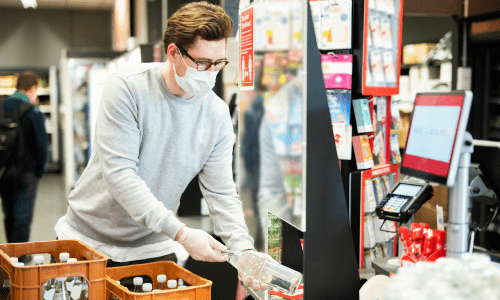
4.30.20 – SSI –Ben Ziomek
While video analytics can form the core of a COVID-19 response to help open shuttered facilities, no AI platform will be sufficient by itself.
There is a tendency in the security industry to look at artificial intelligence (AI) investments as either a panacea or just security theater. In normal times, either approach can gradually be developed into a coherent video analytics strategy over time, but COVID-19 is redefining what it means to ensure public safety — and the tools we use to do it.
Security decision-makers are considering new tactics designed to help shuttered businesses reopen safely, weighing costly options against privacy concerns in their organizations that could damage goodwill toward security initiatives.
As more businesses adopt solutions like thermal imaging for fever detection and AI that can detect social distancing violations, it’s more important than ever to be realistic about what we can expect from AI. Video analytics AI solutions can help organizations manage reopening their facilities that were closed by the coronavirus pandemic, but they need to be clear what their goals are for a new AI solution. If they want their investments to result in anything other than a false peace of mind, they must specifically target their use of analytics to solve specific issues.
Take thermal imaging as an example. Many organizations are looking into using thermal cameras to screen people before they enter their facilities in the hope of controlling transmission. While this makes sense on the face of it, it ignores the fact that much of the challenge of COVID-19 lies in asymptomatic transmission. Additionally, thermal imaging isn’t accurate enough to be a sole check for fevers. Installing thermal imaging without a healthcare worker-staff screening station and ability to send people home accomplishes nothing.Related:Examining AI Trends and Growth in Home Security
There have also been reports of numerous fake or at least highly misleading claims made by thermal imaging products on the market. When a functional solution often runs above $10,000, it means that purchasing a thermal imaging solution is a costly and fraught decision. A security team must know that they can use the system in the context of a complete fever- and health-screening process for it to be worth looking into such systems.
In part because of the complexity of checking employees and customers for symptoms, a new generation of AI that can detect social distancing violations has appeared on the market. My firm, Actuate, produced a Cloud-based social distancing detection platform in response to customer demand. These solutions are much cheaper and more effective in their stated purpose than thermal imaging, but they also need to form part of a larger response. Security teams need to ask themselves what they plan to do with data around social distancing once they have it.
There are two general paths that firms can take: Alert security staff of distancing violations and address specific problems, or track data over time and use it to remind stakeholders to distance effectively. The former approach can be effective if deployed internally in an essential business, although employees may balk at being called out, and is likely far too aggressive for use in a customer-facing environment. Tracking data over time can be useful, but security teams need to have a plan on how to educate stakeholders of proper social distancing, perhaps in collaboration with marketing.
While video analytics can form the core of a COVID-19 response to help open shuttered facilities, no AI platform will be sufficient by itself. Thermal imaging is expensive and ineffective without an even-more-costly health response backing it up, and social distancing AI likewise needs to be supported with a coherent messaging strategy.Related:Contending With the COVID-19 Crisis: A Security Business Continuity Roundtable
It’s up to security decision-makers to step up and work with the business to craft a coherent strategy for reopening, and then let the strategy drive technology purchases rather than the other way around.
Starting from technology rather than strategy is not just expensive, but it can lead to sub-par outcomes. If employees and customers know that thermal imaging or social distancing AI is deployed but the technology is not backed up by a strong security response, they may become lax in other key protective measures such as mask-wearing and hand washing.
Unless new technology deployments are driven by a strong mission and set of goals, they will only create a false sense of security rather than a truly secure environment. It’s up to security decision-makers to provide the vision their organizations need to reopen safely.
Ben Ziomek is Co-founder and Chief Product Officer of computer vision company Actuate.
